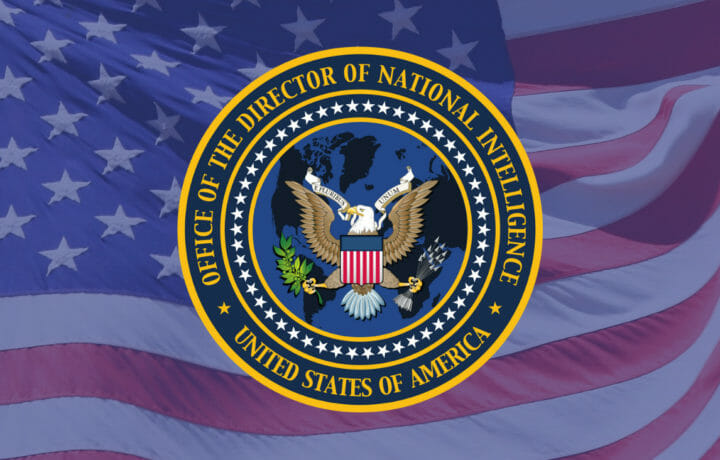On Wednesday, Director of National Intelligence (DNI) Tulsi Gabbard announced that the Office of the Director of National Intelligence (ODNI) would see its workforce reduced by more than 40% by the end of fiscal year 2025 (FY25) as part of an effort to save over $700 million annually, while better allowing ODNI to fulfill its critical role of serving as the central hub for the U.S. intelligence community (IC).
The office noted that it was established following the September 11, 2001, terrorist attacks on the Pentagon and New York City’s World Trade Center. Gabbard warned that the ODNI now falls short of its mandate.
“Over the last 20 years, ODNI has become bloated and inefficient, and the intelligence community is rife with abuse of power, unauthorized leaks of classified intelligence, and politicized weaponization of intelligence,” Gabbard said in a statement.
“ODNI and the IC must make serious changes to fulfill its responsibility to the American people and the U.S. Constitution by focusing on our core mission: find the truth and provide objective, unbiased, timely intelligence to the President and policymakers,” she added. “Ending the weaponization of intelligence and holding bad actors accountable are essential to begin to earn the American people’s trust, which has long been eroded. Under President Trump’s leadership, ODNI 2.0 is the start of a new era focused on serving our country, fulfilling our core national security mission with excellence, always grounded in the U.S. Constitution, and ensuring the safety, security, and freedom of the American people.”
Is Now the Right Time for the Cuts?
The staff reduction comes as the United States could face ongoing threats from Russia, China, North Korea, and Iran, as well as from rogue actors and even international drug cartels.
“Tulsi Gabbard’s sweeping cuts at the Office of the Director of National Intelligence land like a hammer at the very moment when coordination and speed of analysis are most vital,” warned geopolitical analyst Irina Tsukerman, president of threat assessment firm Scarab Rising.
Tsukerman told ClearanceJobs that halving the staff and slashing the budget is not a surgical reform aimed at eliminating redundancy; rather, it is a deliberate dismantling of the connective tissue that binds the intelligence community into something greater than the sum of its parts.
“ODNI was never designed to be glamorous,” Tsukerman added. “Its role was to ensure that signals from the CIA, NSA, FBI, and military intelligence did not conflict, that blind spots did not emerge in the cracks between agencies. Stripping that hub down now risks returning Washington to the pre-9/11 problem of stove-piped agencies protecting their turf and missing the larger picture.”
Fighting Bloat?
Advocates of these cuts have argued that ODNI had become bloated, a bureaucratic drag on decision making, and that leaner government delivers sharper, faster intelligence.
“There is some truth to that critique,” said Tsukerman. “Any coordinating body is vulnerable to inefficiency, and ODNI has often been accused of duplicating efforts already underway in the field. Yet the question is not whether ODNI was perfect, but whether tearing it apart in this moment enhances or degrades national security. Doing so while threats from Russia, China, Iran, and non-state actors are converging makes the logic perilous. A leaner structure without robust mechanisms for analytic independence risks funneling intelligence through narrower political filters, ensuring speed at the cost of integrity.”
The issues with the cuts are also about how it is being undertaken, warned Kristen Patel, professor of practice at Syracuse University’s Maxwell School of Citizenship and Public Affairs. She told Clearancejobs that the bloat has become common as ODNI has grown.
“I’ve heard people complain about it within the IC,” said Patel, “There have also been arguments that DNI has grown beyond its original intent. There is always a process of streamlining and covering the priorities effectively, but this doesn’t seem to be an effective way to do it.”
For one, Patel said that people are being fired for political reasons, not bureaucratic reasons. But it has been in the crosshairs for a while. It is unclear what it means for the workforce in the near term.
“The ODNI size has been an issue from the very beginning,” said Dan Meyer, national security partner at Tully Rinckey PLLC.
“This will touch off gaming by the 17 intelligence community agencies to control the billets that remain,” he told ClearanceJobs. “For ODNI employees, they will relocate to other agencies to which they have ties, probably pushing out contractors, or retire. Congress has left them open to attack, as their employee rights are limited.”
Can The Intelligence be Trusted?
The bigger issue beyond the workforce is what this means for the U.S. IC and how it works with its partners and allies around the world. The cuts to the workforce may make the intelligence less trustworthy in some cases.
“That could lead to institutional confirmation bias,” suggested Patel, who added that it may result in projecting and even cherry picking of intelligence.
Worse is that our partners may question the intelligence, as well as what is shared with the U.S.
“The mass revocation of clearances alongside the budget reduction is not just a bureaucratic shuffle; it is a strategic communication signaling adversaries that time is ripe for exploiting the vulnerabilities in the U.S. strategic infrastructure,” warned Tsukerman. “When seasoned analysts lose access or positions, institutional knowledge vanishes.”
Even worse, the decision to cut ODNI in half is not occurring in a vacuum.
“It is happening in a political climate where distrust of institutions is being weaponized,” Tsukerman added. “At a moment that demands resilience, clarity, and strong coordination…the price of these cuts may not be measured in dollars saved but in blind spots created, warnings missed, and crises that spiral because the seams could not hold.”




